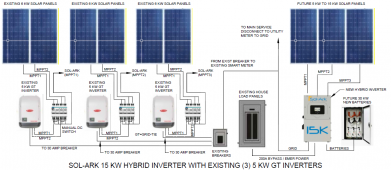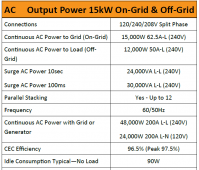Not Aerosmith
Solar Enthusiast
- Joined
- Sep 8, 2022
- Messages
- 389
I have been trying to figure how to convert existing GT inverters system into a hybrid system. When I think that I have found a solution there always seems to be issues with the manufacturer recommended installation. They also provide little help in connecting existing GT inverters to a Hybrid Inverters. Manufacturer's focus is for you to use their equipment and buy more of their equipment to make it work. I finally decided that if I DIY my own diagram for installation most of the issues can be solved.
Attached is a proposed one-line diagram for the installation of existing (3) 5 KW GT inverters to a new Sol-Ark 15 KW:

With this installation, you only need to buy one major component the new hybrid inverter. New solar panels and new batteries are not needed, but can be added in the future. Production can be increased from 15 KW to 20 KW to 25 KW to 30 KW simply by adding additional solar panels. There are no issues about trying to AC coupling existing inverters to a new Hybrid inverter and being able to control them or if they are UL1741 or UL1741SA certified. We are connecting the solar panels not the inverters to the Sol-Ark.
Since Sol-Ark can operate without batteries, you can add batteries in the future as desired. If you want Sol-Ark UPS mode, batteries are needed for UPS to work without adequate sunlight.
The manufacturer suggests connecting your existing GT inverters to the generator connection. I believe during an outage that Sol-Ark can best match production with consumption, if the existing solar panels were connected to the Sol-Ark instead of the GT inverters. Furthermore, if you use the generator connection for the GT inverters, you lose your other choices of using it for a generator, dump load, well pump, etc. If you connect the existing GT inverters to the generator connection, I don't believe the Sol-Ark will work without adding batteries or solar panels.
This is an inexpensive way to provide backup power to an existing GT system by adding a hybrid inverter without needing to add solar panels or batteries. If the Sol-Ark has problems, I can immediately switch the solar panels manually from Sol-Ark back to Fronius. I believe the Sol-Ark is suppose to fail in the 200 amp bypass mode. If so, my system would revert back to its operation prior to adding the Sol-Ark inverter.
There are concerns about the selector switch rating and needing to be switch not under load to prevent flash or arcs that can damaged the contacts. A work around solution is not to use a selector switch, but connect the Fronius or Sol-Ark to the existing solar panels with MC4 connectors.
This is a one line diagram proposed for my existing GT inverters, which could easily be modified for other existing GT systems with different capacities. If there was a problem with the Sol-Ark, it is an easy changeover from Sol-Ark inverter to a Fronius inverters. It is also an easy changeover from Sol-Ark to existing inverters to free the Sol-Ark's MPPTs for adding new solar panels.
Attached is a proposed one-line diagram for the installation of existing (3) 5 KW GT inverters to a new Sol-Ark 15 KW:

With this installation, you only need to buy one major component the new hybrid inverter. New solar panels and new batteries are not needed, but can be added in the future. Production can be increased from 15 KW to 20 KW to 25 KW to 30 KW simply by adding additional solar panels. There are no issues about trying to AC coupling existing inverters to a new Hybrid inverter and being able to control them or if they are UL1741 or UL1741SA certified. We are connecting the solar panels not the inverters to the Sol-Ark.
Since Sol-Ark can operate without batteries, you can add batteries in the future as desired. If you want Sol-Ark UPS mode, batteries are needed for UPS to work without adequate sunlight.
The manufacturer suggests connecting your existing GT inverters to the generator connection. I believe during an outage that Sol-Ark can best match production with consumption, if the existing solar panels were connected to the Sol-Ark instead of the GT inverters. Furthermore, if you use the generator connection for the GT inverters, you lose your other choices of using it for a generator, dump load, well pump, etc. If you connect the existing GT inverters to the generator connection, I don't believe the Sol-Ark will work without adding batteries or solar panels.
This is an inexpensive way to provide backup power to an existing GT system by adding a hybrid inverter without needing to add solar panels or batteries. If the Sol-Ark has problems, I can immediately switch the solar panels manually from Sol-Ark back to Fronius. I believe the Sol-Ark is suppose to fail in the 200 amp bypass mode. If so, my system would revert back to its operation prior to adding the Sol-Ark inverter.
There are concerns about the selector switch rating and needing to be switch not under load to prevent flash or arcs that can damaged the contacts. A work around solution is not to use a selector switch, but connect the Fronius or Sol-Ark to the existing solar panels with MC4 connectors.
This is a one line diagram proposed for my existing GT inverters, which could easily be modified for other existing GT systems with different capacities. If there was a problem with the Sol-Ark, it is an easy changeover from Sol-Ark inverter to a Fronius inverters. It is also an easy changeover from Sol-Ark to existing inverters to free the Sol-Ark's MPPTs for adding new solar panels.
Last edited:





